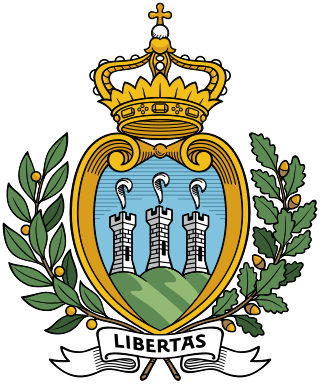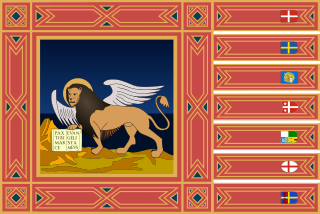| | |||||||
| |||||||
All 60 seats in the Grand and General Council 31 seats needed for a majority | |||||||
| Turnout | 86.28% ( | ||||||
|---|---|---|---|---|---|---|---|
This lists parties that won seats. See the complete results below. | |||||||
 |
|---|
General elections were held in San Marino on 10 June 1906. [1]
| | |||||||
| |||||||
All 60 seats in the Grand and General Council 31 seats needed for a majority | |||||||
| Turnout | 86.28% ( | ||||||
|---|---|---|---|---|---|---|---|
This lists parties that won seats. See the complete results below. | |||||||
 |
|---|
General elections were held in San Marino on 10 June 1906. [1]
The electoral law to was passed on 5 May by the Council elected in March. [2] All householders and graduates over 25 years of age could vote. The republic was divided in nine multi-member constituencies according to their population; the City of San Marino had 22 seats, Serravalle had 12 seats, Faetano had 6 seats, Acquaviva, Chiesanuova, Domagnano and Montegiardino had 4 seats, and Fiorentino and San Giovanni had 2 seats
All councillors were elected in their constituency using a plurality-at-large voting.
Elected candidates belonged to the liberal group which had supported the democratic action of the citizenry meeting or were members of the sole organised party, the Sammarinese Socialist Party, which claimed to have won 29 seats. [3] These two factions formed the first democratic government of the country.
| Party | Votes | % | Seats | |
|---|---|---|---|---|
| Independents | 1,013 | 100.00 | 60 | |
| Total | 1,013 | 100.00 | 60 | |
| Valid votes | 1,013 | 97.59 | ||
| Invalid/blank votes | 25 | 2.41 | ||
| Total votes | 1,038 | 100.00 | ||
| Registered voters/turnout | 1,203 | 86.28 | ||
| Source: Nohlen & Stöver | ||||

The politics of the state of San Marino take place in a framework of a unitary assembly-independent representative democratic republic, whereby the Captains Regent are the heads of state and heads of government. The country has a multi-party system. Executive power is exercised by the government. Legislative power is vested in both the government and the Grand and General Council. The judiciary is independent of the executive and the legislature.

The Sammarinese Christian Democratic Party is a Christian-democratic political party in San Marino.

The Sammarinese Communist Party was a Marxist political party in the small European republic of San Marino. It was founded in 1921 as a section of the Communist Party of Italy (PCI). The organization existed for its first two decades as an underground political organization.
At the national level, the Republic of Cyprus holds elections for its head of state, the President of Cyprus, and for its legislature, the House of Representatives.
Elections in Hungary are held at two levels: general elections to elect the members of the National Assembly and local elections to elect local authorities. European Parliament elections are also held every 5 years.
The Party of Socialists and Democrats is a social-democratic and democratic socialist political party in San Marino. It is a member of the Socialist International, and observer member of the Party of European Socialists. It is the only Sammarinese party with a reference to the European Union in its official political symbol. Its current-day Italian counterpart is the Democratic Party.

The Grand and General Council is the parliament of San Marino. The council has 60 members elected for a five-year term.

The 1983 Italian general election was held in Italy on 26 June 1983. The Pentaparty formula, the governative alliance between five centrist parties, caused unexpected problems to Christian Democracy. The alliance was fixed and universal, extended both to the national government and to the local administrations. Considering that the election result did no longer depend on the strength of the DC, but the strength of the entire Pentapartito, centrist electors began to look at the Christian Democratic vote as not necessary to prevent a Communist success. Moreover, voting for one of the four minor parties of the alliance was seen as a form of moderate protest against the government without giving advantages to the PCI. Other minor effects of this election were a reduction of the referendarian Radical Party and the appearance of some regional forces.

General elections were held in Italy on Sunday, 2 June 1946. They were the first after World War II and elected 556 deputies to the Constituent Assembly. Theoretically, a total of 573 deputies were to be elected, but the election did not take place in the Julian March and in South Tyrol, which were under military occupation by the United Nations.

The Politics of Veneto, a Region of Italy takes place in a framework of a semi-presidential representative democracy, whereby the President is the head of government, and of a pluriform multi-party system. Executive power is exercised by the Regional Government. Legislative power is vested in both the government and the Regional Council.

The Politics of Lombardy, Italy, takes place in a framework of a semi-presidential representative democracy, whereby the President of the Region is the head of government, and of a pluriform multi-party system. Legislative power is vested in the Regional Council of Lombardy, while executive power is exercised by the Regional Government led by the President, who is directly elected by the people. The current Statute, which regulates the functioning of the regional institutions, has been in force since 2008.

The 2000 Hong Kong Legislative Council election was held on 10 September 2000 for members of the 2nd Legislative Council (LegCo) of the Hong Kong Special Administrative Region (HKSAR). The election returned 24 members from directly elected geographical constituencies, 6 seats from the Election Committee constituency and 30 members from functional constituencies, of which 9 uncontested.

Trade Unionist and Socialist Coalition (TUSC) is a socialist electoral alliance launched in Britain for the 2010 general election.

General elections were held in San Marino on 19 June 1909 to elect the second term of the Grand and General Council.

General elections were held in San Marino on 23 June 1912 to elect the third term of the Grand and General Council.

General elections were held in San Marino on 13 June 1915 to elect the fourth term of the Grand and General Council.

General elections were held in San Marino on 9 June 1918 to elect the fifth term of the Grand and General Council.

General elections were held in San Marino on 14 November 1920 to elect the sixth term of the Grand and General Council. It was the country's first snap election, and the first election to use a form of proportional representation. The result was a victory for the Sammarinese People's Party, which won 29 of the 60 seats.

General elections were held in San Marino on 4 March 1923 to elect the seventh term of the Grand and General Council. It was a snap election that marked the beginning of fascist rule in the republic. Left-wing parties were prevented from participating, while all centre-right forces ran as a single "Patriotic Bloc". Of the 60 seats, 29 were taken by the Sammarinese Fascist Party, 20 by the Sammarinese People's Party, 9 by the Sammarinese Democratic Union and two by the Fascist-puppets Volunteers of War. Later the country was taken over by the Fascist Party.
General elections were held in San Marino on 11 November 2012. The 60 seats in the Grand and General Council were up for grabs. The elections were held using the majority bonus system. The previous election, held in 2008, provided the Sammarinese Christian Democratic Party with the largest single parliamentary group. The Party of Socialists and Democrats, although winning more votes than the former, became the main opposition party.